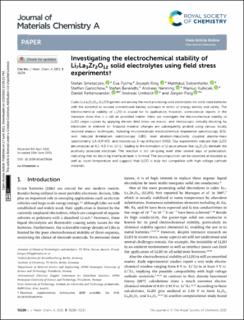| dc.contributor.author | Smetaczek, Stefan | |
| dc.contributor.author | Pycha, Eva | |
| dc.contributor.author | Ring, Joseph | |
| dc.contributor.author | Siebenhofer, Matthäus | |
| dc.contributor.author | Ganschow, Steffen | |
| dc.contributor.author | Berendts, Stefan | |
| dc.contributor.author | Nenning, Andreas | |
| dc.contributor.author | Kubicek, Markus | |
| dc.contributor.author | Rettenwander, Daniel | |
| dc.contributor.author | Limbeck, Andreas | |
| dc.contributor.author | Fleig, Jürgen | |
| dc.date.accessioned | 2022-01-26T12:37:54Z | |
| dc.date.available | 2022-01-26T12:37:54Z | |
| dc.date.created | 2021-12-28T21:45:55Z | |
| dc.date.issued | 2021 | |
| dc.identifier.citation | Journal of Materials Chemistry A. 2021, 9, . | en_US |
| dc.identifier.issn | 2050-7488 | |
| dc.identifier.uri | https://hdl.handle.net/11250/2839448 | |
| dc.description.abstract | Cubic Li7La3Zr2O12 (LLZO) garnets are among the most promising solid electrolytes for solid-state batteries with the potential to exceed conventional battery concepts in terms of energy density and safety. The electrochemical stability of LLZO is crucial for its application, however, controversial reports in the literature show that it is still an unsettled matter. Here, we investigate the electrochemical stability of LLZO single crystals by applying electric field stress via macro- and microscopic ionically blocking Au electrodes in ambient air. Induced material changes are subsequently probed using various locally resolved analysis techniques, including microelectrode electrochemical impedance spectroscopy (EIS), laser induced breakdown spectroscopy (LIBS), laser ablation-inductively coupled plasma-mass spectrometry (LA-ICP-MS), and microfocus X-ray diffraction (XRD). Our experiments indicate that LLZO decomposes at 4.1–4.3 V vs. Li+/Li, leading to the formation of Li-poor phases like La2Zr2O7 beneath the positively polarized electrode. The reaction is still on-going even after several days of polarization, indicating that no blocking interfacial layer is formed. The decomposition can be observed at elevated as well as room temperature and suggests that LLZO is truly not compatible with high voltage cathode materials. | en_US |
| dc.language.iso | eng | en_US |
| dc.publisher | Royal Society of Chemistry | en_US |
| dc.rights | Navngivelse 4.0 Internasjonal | * |
| dc.rights.uri | http://creativecommons.org/licenses/by/4.0/deed.no | * |
| dc.title | Investigating the electrochemical stability of Li7La3Zr2O12 solid electrolytes using field stress experiments | en_US |
| dc.type | Peer reviewed | en_US |
| dc.type | Journal article | en_US |
| dc.description.version | publishedVersion | en_US |
| dc.source.volume | 9 | en_US |
| dc.source.journal | Journal of Materials Chemistry A | en_US |
| dc.identifier.doi | 10.1039/d1ta02983e | |
| dc.identifier.cristin | 1972556 | |
| cristin.ispublished | true | |
| cristin.fulltext | original | |
| cristin.qualitycode | 1 | |

